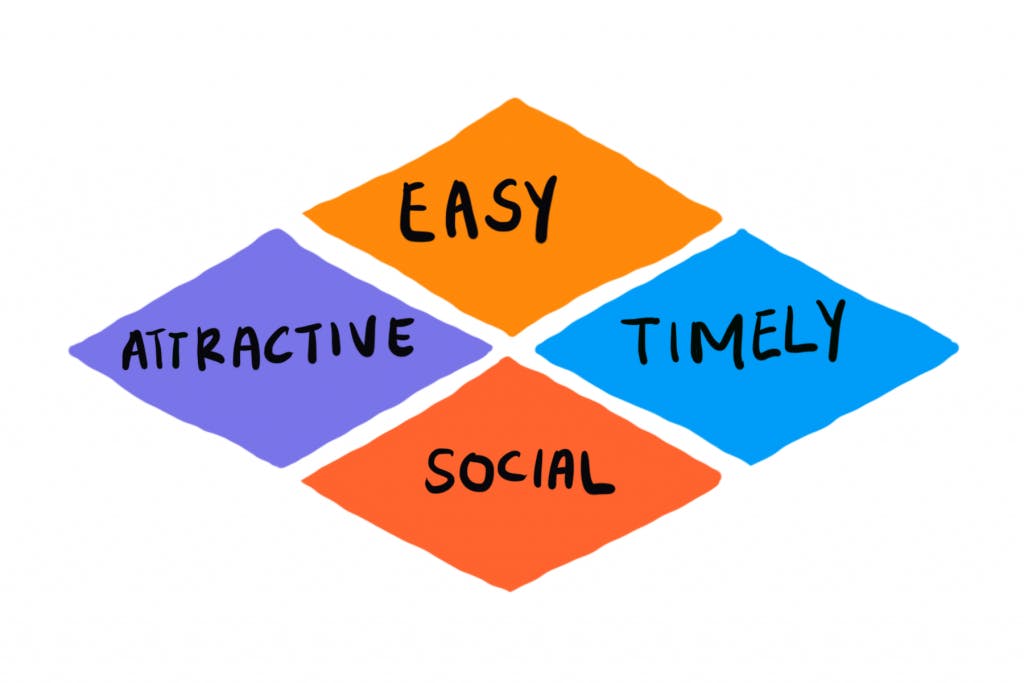EAST Framework
What is a Framework?
Behavior change frameworks are the bedrock of applied behavioral science. Designed by behavioral scientists for policy makers and industry leaders, these summaries of cutting edge decision-making insights are essential for applying research in the public and private spheres. Frameworks distill strategies for influencing human decisions into simple, portable mnemonic devices or acronyms. This makes it possible for complex, theoretical insights about how people think and act to make their way into the practices of organizations across every industry and environment. To understand more about how these frameworks work in practice, check out our case studies.
Theory, meet practice
TDL is an applied research consultancy. In our work, we leverage the insights of diverse fields—from psychology and economics to machine learning and behavioral data science—to sculpt targeted solutions to nuanced problems.
The Basic Idea
Developed by the Behavioral Insights Team (BIT) in 2012, the EAST framework provides a simple outline for policymakers to optimize their work using behavioral science. More specifically, the EAST framework is designed to improve public policy by using nudging, social engineering, and other psychological and economics methods. The EAST Framework is composed of four ideals, which designate that a policy should be Easy, Attractive, Social, and Timely (EAST). Additionally, the Behavioural Insights Team developed an Implementation Plan which outlines the key steps for rolling out EAST-based policies.

Key Terms
Easy:
In the EAST Framework, “E” stands for Easy: making policies with as minimal effort as possible. In general, people tend to give up on tasks when faced with many obstacles. The EAST framework therefore provides techniques to combat this tendency. Firstly, since people typically subscribe to default options, making the desired behavior the default state increases the likelihood it will be adopted. By a similar vein, policymakers can alter the levels of friction to create more or less difficulty in competing behaviors. They make the preferred decision easier to choose, and by the same token, they make less preferred decisions more difficult.
Finally, when providing the public with information, the “Easy” part of the framework suggests making messages clear and simple. Topics that are too complex or detail-oriented are likely to be ignored.
Attractive:
In order for a policy to be taken up, it is necessary for it to be noticed. To get people’s attention, policy documents and advertisements should use salient images, colors, and personalized details. Furthermore, to increase uptake, it is also useful to use attractive incentives to promote particular behaviors. These incentives are designed to make policies more worthy of the participant’s time, which can be done through financial rewards, using lottery systems, or “gamifying” policy activities to make them more enjoyable.
Social:
As social beings, people typically enjoy being part of groups. Furthermore, being part of a group used to be necessary for survival. Therefore, we are highly influenced by the thoughts, approval, and behavior of others. By harnessing our reliance on other people’s approval, policymakers can influence behavior.
One technique involves convincing people that the vast majority of others engage in the preferred behavior. This technique takes advantage of the bandwagon effect, which is our habit of engaging in activities and beliefs as they gain popularity.
Another technique involves fostering communities and networks to hold individuals accountable. This technique works because groups develop social norms, which diminishes the amount of effort group members need to make in order to fit in with others. For example, weight loss communities minimize the difficulty of losing weight by holding each other accountable and fostering a sense of mutual responsibility. Similarly, we often vow to do something, and end up procrastinating or forgetting about it entirely. The EAST framework suggests that if we make an explicit commitment to others, we are more likely to follow through.
Timely:
Utilizing the correct timing when implementing policy can be very important for public perception. People’s perceptions are influenced by context and their unique life situations. The EAST Framework recommends that policies should be rolled out when individuals are most receptive to them, which typically occurs with significant changes or life events. As we don’t change our habits often, major life transitions allow for drastic shifts in our habits, and are durations when we are likely to be more receptive to changing our behavior.
Furthermore, if a policy includes specific costs or benefits, it is important to acknowledge when someone will receive them. Unfortunately, many policies have high upfront costs, while the benefits created by the policy are not generated for years to come. For example, imagine a government is doing a much-needed expansion of their medical system. This policy, while important, will take many years to complete, as well lead to an increase in taxes for the first few years. People are typically biased towards thinking in terms of their present well-being, so this overhaul, while necessary, might be unpopular due to its high immediate costs. Reducing instant costs or increasing immediate benefits can help with the uptake of programs.
Implementation Plan
Often, we fail to fulfill our goals, despite our best intentions. This failure is often due to a lack of planning, and it can therefore be helpful for policies to come with corresponding action plans. Action plans attached to policies are called “implementation intentions.” These action plans identify potential barriers to achieving the intervention’s goals and suggest ways to overcome these barriers
The BIT outlines four-steps process to complete the goals of a policy intervention:
- Define the outcome: Be clear about the project’s aim and set specific goals, defined by key metrics.
- Examine the context: Understand both the constraints of the business or community being helped. Without proper understanding of how a system works, intervention can lead to unintended and dangerous behavioral side-effects.
- Create the policy: Draft the intervention.
- Assess effectiveness: Repeatedly reassess the intervention’s effectiveness by testing, learning from, and adapting the resulting behavior to meet goals.
History
In 2012, the UK’s Behavioral Insights Team was looking to simplify their MINDSPACE framework. The team found that policymakers struggled to remember the nine insights that make up the MINDSPACE program. In an effort to improve the memorability of their model, the BIT developed the EAST Framework. This framework was intended to provide policymakers with a list of the most effective influences on public behavior. The goal was to create a robust framework simple enough for any policymaker to implement with ease into policy design.
Key People
Founded in 2010, the Behavioural Insights Team (also known as the Nudge Unit) is a British social purpose organization that studies, develops, and implements behavioral science. Stationed in the UK, much of their work has been aiding the British government in implementing policies and improving public services by taking advantage of insights about human nature. Taking an empirical approach to policy, the BIT has been successful in helping the British government increase tax collection, improve electoral participation, and enable charitable giving. Recently, they have expanded their work to the United States, Canada, Australia, New Zealand, and Singapore.
Consequences
Since its conception, the EAST Framework has been fundamental for policy design. The Behavioral Insights Team have demonstrated the framework’s benefits for public policy in the United Kingdom in multiple different situations.
Recently, both the UK and Canadian province of British Columbia recently used techniques from the EAST framework to assist in the creation of their public health policies surroundingCOVID-19 responses The EAST Framework has also been helpful to marketing teams, as it has been known to improve customer experience and click-through rates. Overall, the EAST framework has become a staple for implementation of behavioral insights across industries and the world.
Controversies
The EAST framework relies on multiple different techniques, but ultimately is based on nudging. Nudging describes choice architects’ ability to influence the public’s choices through purposeful design. In essence, nudging creates an environment in which one is free to choose, but certain decisions are more cognitively taxing than others. In an intervention, for example, this might look like influencing people’s behavior in subtle ways of which they are not informed. Because of its paternalistic tendencies and ethical ambiguities, nudge theory has been criticized and said to be a rebranded form of psychological manipulation.
Proponents of nudge theory, however, argue that there is no way to make a choice neutral, and that all choices harbor inherent framing and bias, whether explicit or implicit. We should therefore judge nudges based on their specific use rather than based on discomfort with the idea of choice architecture.
Case Study
Nudging People back to work - JobCentre Plus
A good example of a recent application of the EAST Framework is the BIT’s program for Jobcentre Plus, the UK government’s employment service agency. The Jobcentre Plus was struggling to get people back to work, and called on the BIT for advice. The BIT took the following actions:
- They made the sign-up process easier by reducing the amount of forms
- They made the program more attractive by personalizing advisors to each individual; made the process more social by having the job seekers commit to weekly advisory meetings
- They made it more timely, by having the job seeker start to make plans on day one about getting back to work.
Related TDL Content
Nudges Work (and practitioners know exactly how well)
If you are interested in better understanding how nudges work, this article features experts Dr. Elizabeth Linos and Dr. Stefano DellaVigna, who discuss the effectiveness of nudging, how nudges work, and what to look out for in the field, moving forward.
Nudges: Social Engineering or Sensible Policy?
In this piece, TDL contributor Jared Celniker dives into the ethical argument surrounding nudging. Specifically, he assesses the importance of transparency and motives behind choice architecture, the partisan divide on nudging, and nudges’ effectiveness in promoting social good.
Sources
- The Behavioural Insights Team. (2014, April 11). East: Four simple ways to apply behavioural insights. Retrieved April 07, 2021, from https://www.bi.team/publications/east-four-simple-ways-to-apply-behavioural-insights/
- Gollwitzer, P. M. (1999). Implementation intentions: Strong effects of simple plans. American Psychologist, 54(7), 493-503. doi:10.1037/0003-066x.54.7.493
- The Behavioural Insights Team. (2019). Case studies. Retrieved April 07, 2021, from https://www.bi.team/case-studies/
- The Behavioural Insights Team. (n.d.). Our Offices. Retrieved April 07, 2021, from https://www.bi.team/our-offices/
- See 1.
- SIBONY A. L. (2020). The UK COVID-19 Response: A Behavioural Irony?. European Journal of Risk Regulation, 1–8. https://doi.org/10.1017/err.2020.22
- BC Behavioural Insights Group. (2020). Behavioural Insights: How Local Governments are responding to the COVID-19 pandemic. Retrieved April 07, 2021, from https://irp-cdn.multiscreensite.com/be9aba85/files/uploaded/Local%20Government%20Resource%20for%20COVID-19%20-%20BC%20Behavioural%20Insights%20Group.pdf
- https://www.smartinsights.com/user-experience/customer-experience-management-cxm/use-east-behavioural-insights-framework-improve-customer-experience/
- Barton, A., & Grüne-Yanoff, T. (2015). From libertarian paternalism TO Nudging—and Beyond. Review of Philosophy and Psychology, 6(3), 341-359. doi:10.1007/s13164-015-0268-x

